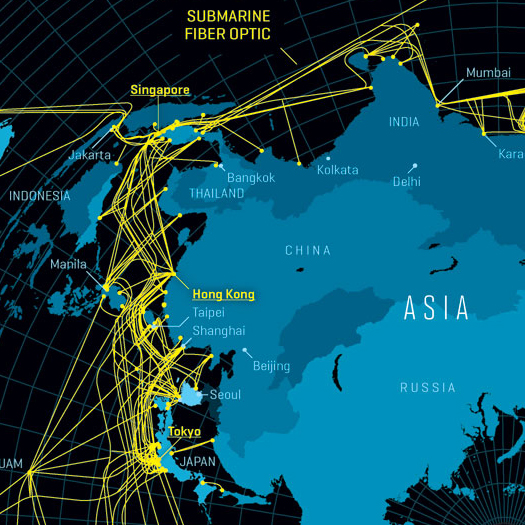
[A portion of Nicolas Rapp’s map of the internet for Fortune magazine.]
Writing for Quaderns, Kazys Varnelis argues for an infrastructural urbanism that not only embraces and seeks to design (or design with) infrastructure, but also imagines new infrastructures “more appropriate to network culture”:
But we have not gone far enough yet. The Deleuzian modulations that govern our society are increasingly invisible. Like it or not, just as industry once took over from agriculture, finance has come to dominate economies across the globe. We all need to eat, we all need to dress in clothes and inhabit houses, but economies are increasingly governed by the financial sector and its demands. Nor does finance find itself easily grounded: trading floors across the world are emptying out, unable to keep up with the ultra-rapid movements of liquidity in anonymous facilities such as the NYSE Euronext installations in Mahwah, New Jersey, and Basildon, a suburb east of London.
The financial services sector reflects our condition of living in Hertzian space—the cloud of electromagnetic signals that surrounds us—as much as in physical space. Take a look at a city street: passers-by relentlessly text each other, listen to music on their iPods, navigate with geolocative devices or talk on wireless phones.
Physicists tell us that electromagnetic forces are far more powerful than gravity (a tiny magnet holds up a paperclip against the entire gravity of the Earth). As I write this, destroyed nuclear power plants smoulder on Japan’s Pacific coast, carving out vast exclusion zones across the island nation’s inland territory. Proponents of infrastructural urbanism often cite flocking conditions exhibited by birds, marine mammals and other animals as examples of the sort of effects they wish to achieve, embracing both the individual and the collective, autonomous agency and massive change. But these behaviours are not made solely according to a genetically encoded rule set. Rather, they are done with reference to the invisible but very real electromagnetic world. Even though we cannot directly perceive the electromagnetic spectrum, the way we have reshaped its modulations impacts the behaviour of such creatures. It is time for architects to understand that the structures of infrastructural modernity are just so many ruins and, in conceiving of new infrastructures for the millennium, to learn how to embrace the new modulated world of invisible fields.

